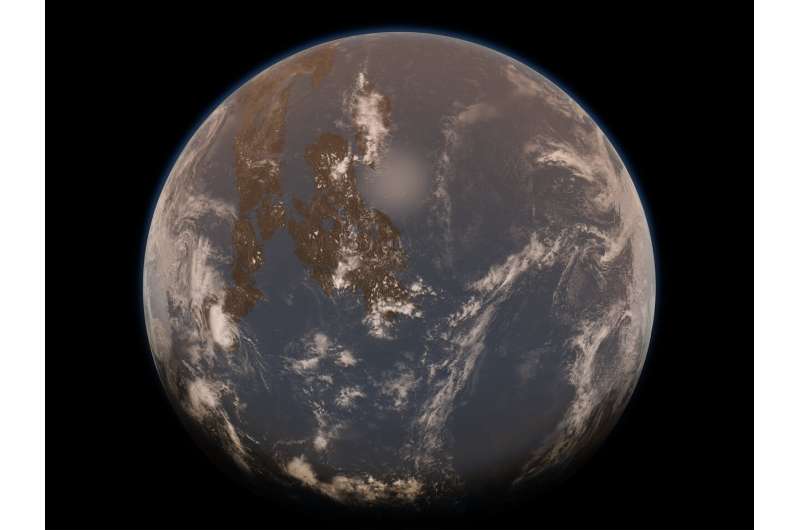Early Earth's hot mantle may have led to Archean 'water world'

A vast global ocean may have covered early Earth during the early Archean eon, 4 to 3.2 billion years ago, a side effect of having a hotter mantle than today, according to new research.
The new findings challenge earlier assumptions that the size of the Earth's global ocean has remained constant over time and offer clues to how its size may have changed throughout geologic time, according to the study's authors.
Most of Earth's surface water exists in the oceans. But there is a second reservoir of water deep in Earth's interior, in the form of hydrogen and oxygen attached to minerals in the mantle.
A new study in AGU Advances, which publishes high-impact, open-access research and commentary across the Earth and space sciences, estimates how much water the mantle potentially could hold today and how much water it could have stored in the past.
The findings suggest that, since early Earth was hotter than it is today, its mantle may have contained less water because mantle minerals hold onto less water at higher temperatures. Assuming that the mantle currently has more than 0.3-0.8 times the mass of the ocean, a larger surface ocean might have existed during the early Archean. At that time, the mantle was about 1,900-3,000 degrees Kelvin (2,960-4,940 degrees Fahrenheit), compared to 1,600-2,600 degrees Kelvin (2,420-4,220 degrees Fahrenheit) today.
If early Earth had a larger ocean than today, that could have altered the composition of the early atmosphere and reduced how much sunlight was reflected back into space, according to the authors. These factors would have affected the climate and the habitat that supported the first life on Earth.
"It's sometimes easy to forget that the deep interior of a planet is actually important to what's going on with the surface," said Rebecca Fischer, a mineral physicist at Harvard University and co-author of the new study. "If the mantle can only hold so much water, it's got to go somewhere else, so what's going on thousands of kilometers below the surface can have pretty big implications."
Earth's sea level has remained fairly constant during the last 541 million years. Sea levels from earlier in Earth's history are more challenging to estimate, however, because little evidence has survived from the Archean eon. Over geologic time, water can move from the surface ocean to the interior through plate tectonics, but the size of that water flux is not well understood. Because of this lack of information, scientists had assumed the global ocean size remained constant over geologic time.
In the new study, co-author Junjie Dong, a mineral physicist at Harvard University, developed a model to estimate the total amount of water that Earth's mantle could potentially store based on its temperature. He incorporated existing data on how much water different mantle minerals can store and considered which of these 23 minerals would have occurred at different depths and times in Earth's past. He and his co-authors then related those storage estimates to the volume of the surface ocean as Earth cooled.
Jun Korenaga, a geophysicist at Yale University who was not involved in the research, said this is the first time scientists have linked mineral physics data on water storage in the mantle to ocean size. "This connection has never been raised in the past," he said.
Dong and Fischer point out that their estimates of the mantle's water storage capacity carry a lot of uncertainty. For example, scientists don't fully understand how much water can be stored in bridgmanite, the main mineral in the mantle.
The new findings shed light on how the global ocean may have changed over time and can help scientists better understand the water cycles on Earth and other planets, which could be valuable for understanding where life can evolve.
"It is definitely useful to know something quantitative about the evolution of the global water budget," said Suzan van der Lee, a seismologist at Northwestern University who did not participate in the study. "I think this is important for nitty-gritty seismologists like myself, who do imaging of current mantle structure and estimate its water content, but it's also important for people hunting for water-bearing exoplanets and asking about the origins of where our water came from."
Dong and Fischer are now using the same approach to calculate how much water may be held inside Mars.
"Today, Mars looks very cold and dry," Dong said. "But a lot of geochemical and geomorphological evidence suggests that early Mars might have contained some water on the surface—and even a small ocean—so there's a lot of interest in understanding the water cycle on Mars."
More information: Junjie Dong et al, Constraining the Volume of Earth's Early Oceans With a Temperature‐Dependent Mantle Water Storage Capacity Model, AGU Advances (2021). DOI: 10.1029/2020AV000323
Journal information: AGU Advances
Provided by American Geophysical Union





















